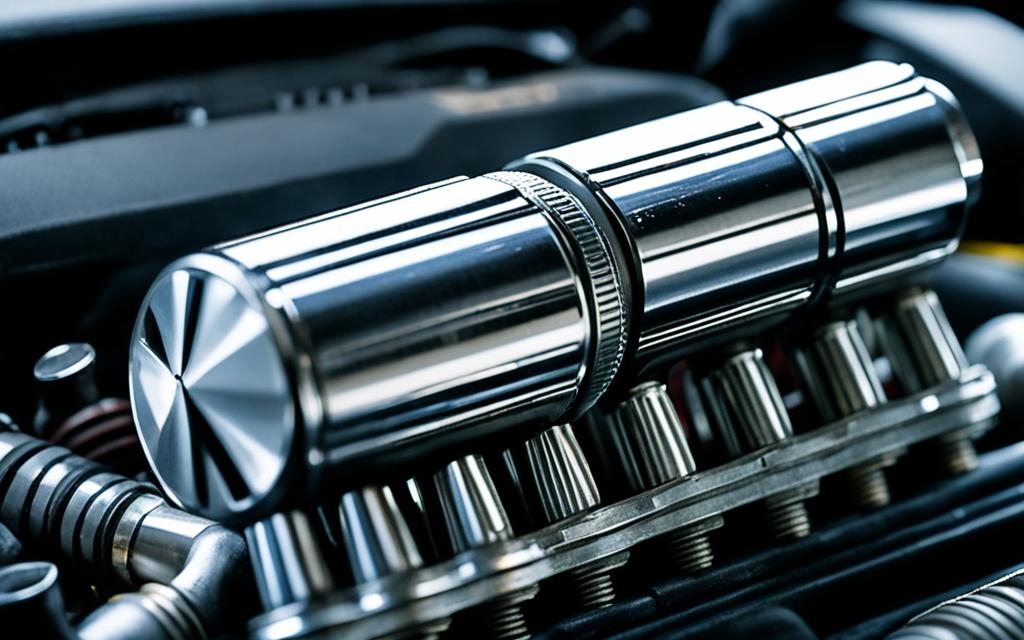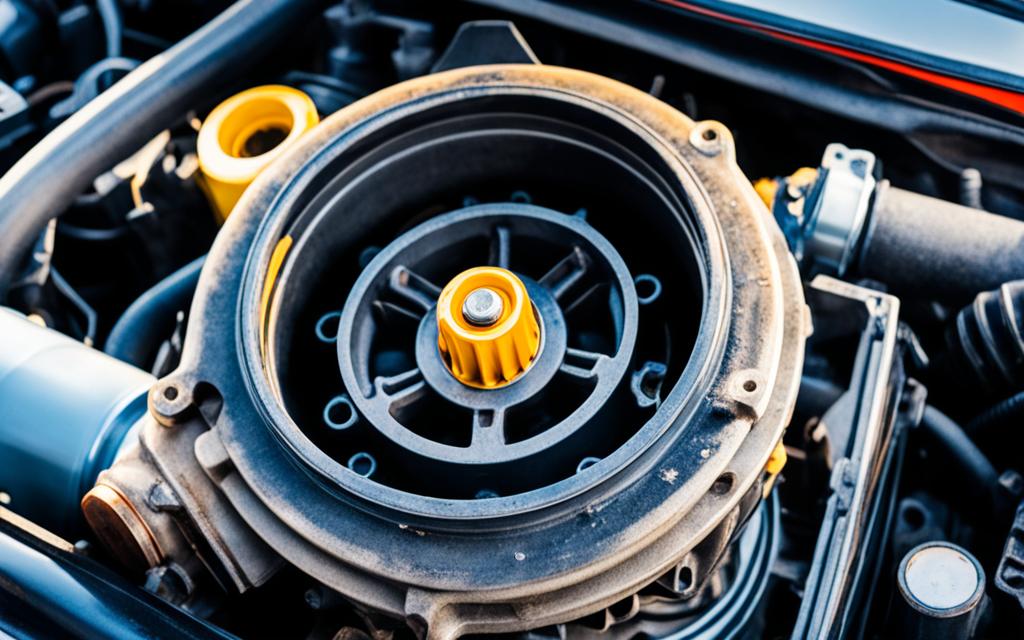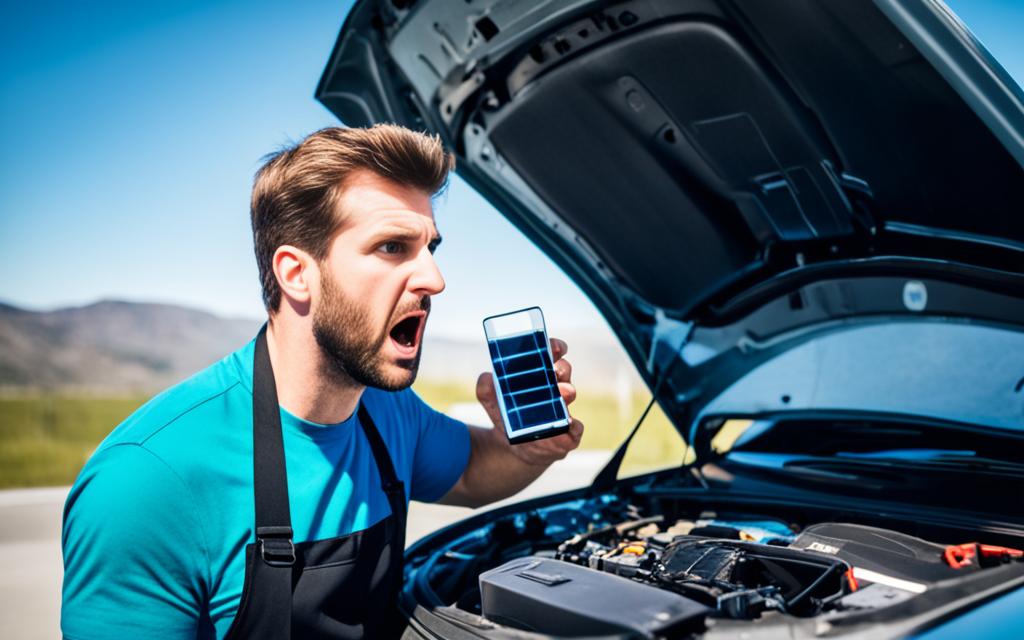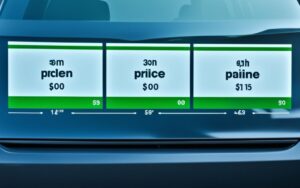If you’re dealing with the frustrating situation of a car not starting, despite having a fully charged battery, you’re not alone. This common issue can leave you feeling helpless and wondering what could be causing the problem. However, there’s good news! In this article, we’ll provide you with a range of quick fixes that can get your car up and running again, without the need for a mechanic.
Before we dive into the solutions, let’s first understand why a car may not start even when the battery is fine. By troubleshooting the potential causes, we can narrow down the issue and find an appropriate fix. From there, we can explore various components, such as the ignition switch, starter motor, fuel system, electrical system, sensors, spark plugs, timing belt, distributor cap, and rotor, along with other potential causes that may be preventing your car from starting.
Key Takeaways
- Even if your battery is fully charged, there are several possible causes for a car not starting.
- Common troubleshooting steps include checking the ignition switch, starter motor, fuel system, electrical system, sensors, spark plugs, timing belt, distributor cap, and rotor.
- Inspecting and addressing issues with these components can often resolve starting problems.
- Testing fuel pressure and addressing other potential causes should also be considered.
- If you feel unsure or uncomfortable with any of the troubleshooting steps, it’s always best to consult a professional mechanic.
Troubleshooting Car Starting Issues
If you’re facing the frustration of a car not starting, even though the battery is fine, it’s essential to understand the potential causes and how to troubleshoot the problem. In this section, we’ll delve into the common reasons why your car may not start and provide troubleshooting tips to get you back on the road.
Potential Causes for a Car Not Starting
There are various factors that can contribute to a car not starting, even with a good battery. Understanding these potential causes can help you pinpoint the issue and implement the appropriate troubleshooting steps:
- Ignition System Issues: Faulty ignition switch or a malfunctioning starter motor can prevent your car from starting.
- Fuel System Problems: Insufficient fuel pressure, clogged fuel pump, or a faulty fuel filter can hinder your car’s startup.
- Electrical Malfunctions: Problems with the battery, alternator, or other electrical components can impact the starting process.
- Sensor Failures: Faulty sensors, such as the crankshaft position sensor or camshaft position sensor, can disrupt the ignition sequence.
- Spark Plug Issues: Worn-out or damaged spark plugs can lead to ignition failure and prevent your car from starting.
- Timing Belt Problems: A slipped or broken timing belt can disrupt the engine’s timing and hinder startup.
- Distributor Cap and Rotor Concerns: Damaged or worn-out distributor cap and rotor can affect the ignition process.
- Fuel Pressure Abnormalities: Insufficient or excessive fuel pressure can impact the startup of your vehicle.
- Other Potential Causes: Additional factors like faulty wiring, a failing fuel pump relay, or a malfunctioning engine control module (ECM) may also contribute to a car not starting.
By examining these potential causes, you can begin troubleshooting your car starting issue and implement the necessary solutions. In the following sections, we’ll provide detailed instructions on how to address each potential cause, ensuring you have all the information needed to diagnose and resolve the problem.
Summary Table: Potential Causes and Troubleshooting Steps
| Potential Cause | Troubleshooting Steps |
|---|---|
| Ignition System Issues | Check the ignition switch and starter motor for any faults. Replace or repair components if necessary. |
| Fuel System Problems | Inspect the fuel pump, filter, and injectors for any issues. Clean or replace faulty components as required. |
| Electrical Malfunctions | Test the battery, alternator, and other electrical components for proper functioning. Address any electrical issues found. |
| Sensor Failures | Check various sensors for faults, such as the crankshaft or camshaft position sensors. Replace or repair faulty sensors. |
| Spark Plug Issues | Inspect the spark plugs for wear or damage. Replace spark plugs if necessary. |
| Timing Belt Problems | Examine the condition of the timing belt. Replace if it is slipped or broken. |
| Distributor Cap and Rotor Concerns | Inspect the distributor cap and rotor for any signs of damage. Replace or repair if needed. |
| Fuel Pressure Abnormalities | Test the fuel pressure to ensure it is within the recommended range. Adjust or replace components to maintain proper fuel pressure. |
| Other Potential Causes | Investigate issues like faulty wiring, a failing fuel pump relay, or malfunctioning ECM. Take appropriate steps to address these causes. |
Checking the Ignition Switch and Starter Motor
When your car refuses to start, it can be frustrating and inconvenient. One of the common culprits behind a car not turning over or cranking is a faulty ignition switch or starter motor. In this section, we’ll walk you through the steps to troubleshoot these components and get your car back on the road.
Step 1: Check the Ignition Switch
The ignition switch is responsible for initiating the starting process by sending power to the starter motor. If it is faulty, it may not provide the necessary electrical connection for your car to start. Here’s how you can check the ignition switch:
- Ensure your car’s transmission is in park or neutral and the parking brake is engaged for safety.
- Insert the key into the ignition and try turning it to the “on” position. If the dashboard lights and accessories come on, the ignition switch is likely functioning.
- If the dashboard lights and accessories don’t come on, try jiggling the key and turning it again. If there’s still no response, the ignition switch may need to be replaced.
Step 2: Inspect the Starter Motor
The starter motor is responsible for physically turning the engine over and starting the combustion process. If it is malfunctioning, your car won’t crank or turn over. Here’s how you can inspect the starter motor:
- Locate the starter motor, generally found near the bottom of the engine.
- Check the wiring connections attached to the starter motor. Ensure they are secure and free from corrosion.
- If the wiring connections are in good condition, tap the starter motor gently with a rubber mallet or a similar tool while someone tries to start the car. If it starts, the starter motor may have a worn-out or faulty internal component and should be replaced.
| Issue | Possible Causes | Solution |
|---|---|---|
| Car not turning over or cranking | Faulty ignition switch or starter motor | Check the ignition switch and inspect the starter motor |
Remember, if you’re not confident in your DIY skills or if the ignition switch or starter motor needs replacing, it’s best to consult a professional mechanic for assistance. Getting to the root cause of the starting issue will help you avoid further complications and get your car back on the road smoothly.
Inspecting the Fuel System
If your car engine won’t start, one possible culprit could be a malfunctioning fuel system. Even if your battery is fully charged, issues with the fuel pump, filter, or injectors can prevent your car from starting. In this section, we’ll guide you through the process of troubleshooting the fuel system to ensure it’s not the cause of your car’s starting issues.
Step 1: Check the Fuel Pump
The fuel pump is responsible for delivering fuel from the gas tank to the engine. If it fails to supply an adequate amount of fuel, your car may not start. To check the fuel pump:
- Start by listening for a humming sound near the gas tank when you turn the ignition to the “ON” position. This sound indicates that the fuel pump is functioning properly.
- If you don’t hear a humming sound, it’s likely that the fuel pump is faulty and needs to be replaced.
Step 2: Inspect the Fuel Filter
The fuel filter is designed to remove impurities from the fuel before it reaches the engine. Over time, the filter can become clogged, restricting the flow of fuel and causing starting issues. Here’s how you can inspect the fuel filter:
- Locate the fuel filter in your car. It’s typically found along the fuel line, either near the gas tank or the engine.
- Carefully detach the fuel filter from its fittings and examine it for signs of clogging or damage.
- If the filter appears dirty or damaged, it’s recommended to replace it with a new one.
Step 3: Check the Fuel Injectors
Fuel injectors are responsible for delivering fuel to the engine cylinders in a precise amount and spray pattern. If they become clogged or malfunction, it can affect the fuel delivery and lead to starting issues. Follow these steps to inspect the fuel injectors:
- Locate the fuel injectors in your car’s engine. They are usually attached to the fuel rail and can be identified by their small nozzles.
- Inspect each fuel injector for any signs of clogging or leakage.
- If you notice any issues with the fuel injectors, it’s recommended to clean or replace them as necessary.
By inspecting and addressing any potential issues with the fuel system, you can increase the chances of getting your car engine to start smoothly. However, if you’re unsure or uncomfortable performing these inspections yourself, it’s always best to consult a professional mechanic.
“A malfunctioning fuel system can prevent your car from starting, even if the battery is fully charged. Inspecting the fuel pump, filter, and injectors is an important step in troubleshooting car starting issues.” – Car Mechanic Expert
Testing the Electrical System
If your car is not starting despite having a fine battery, the issue might lie in the electrical system. Electrical problems can disrupt the starting process and leave you stranded. To diagnose and resolve any electrical issues, let’s walk through the process of testing the essential components, including the battery and alternator.
Testing the Battery
The first step in troubleshooting your car’s electrical system is to test the battery. A weak or dead battery can prevent your car from starting. Follow these steps to ensure your battery is in good condition:
- Turn off all electrical components, including the headlights and radio.
- Connect a voltmeter to the battery terminals, ensuring the positive (+) and negative (-) connections are correct.
- Check the voltmeter reading. A fully charged battery should measure around 12.6 volts or higher.
- If the voltage is significantly lower, you might need to recharge or replace the battery.
Testing the Alternator
The alternator plays a crucial role in charging the battery while the engine is running. A faulty alternator can prevent your battery from receiving a proper charge and lead to starting issues. Here’s how to test the alternator:
- Start your car and let the engine idle.
- Connect a voltmeter to the battery terminals, similar to the battery testing process.
- Check the voltmeter reading while the engine is running. A functioning alternator should produce around 13.5 to 14.5 volts.
- If the voltage is too low, the alternator may need to be repaired or replaced.
Pro Tip: If you’re unsure about testing the battery or alternator yourself, it’s always a good idea to consult a professional automotive technician for accurate diagnosis and repair.
| Common Electrical System Components | Testing Method | Normal Reading | Action to Take |
|---|---|---|---|
| Battery | Voltmeter | 12.6 volts or higher | Recharge or replace if voltage is significantly lower |
| Alternator | Voltmeter | 13.5 to 14.5 volts | Repair or replace if voltage is too low |
Testing the electrical system is a crucial step in diagnosing starting issues. By checking the battery and alternator, you can identify any underlying electrical problems and take the necessary action. If the battery and alternator tests indicate normal readings, you may need to explore other potential causes for your car’s starting problems.
Checking for Faulty Sensors
Modern cars are equipped with a variety of sensors that play a crucial role in ensuring smooth operation. However, if any of these sensors are faulty, they can lead to car starting problems, even if the battery is fine. In this section, we’ll guide you through the process of checking for faulty sensors and provide steps to address the issue.
Step 1: Diagnostic Scan
Start by performing a diagnostic scan on your car’s onboard computer system. This scan will help identify any error codes related to sensor malfunctions. You can use a diagnostic scanner tool or visit a local auto parts store for a free diagnostic scan.
“Performing a diagnostic scan is the first step in identifying faulty sensors that may be causing your car starting problems.”
Step 2: Check Engine Control Module (ECM)
The Engine Control Module (ECM) is responsible for monitoring and controlling various sensors in your car. Start by inspecting the ECM to ensure it’s properly connected and not damaged.
Step 3: Inspect Individual Sensors
Next, you’ll need to inspect each sensor individually. Some common sensors that can affect car starting include:
- Mass Airflow Sensor (MAF)
- Throttle Position Sensor (TPS)
- Crankshaft Position Sensor (CKP)
- Camshaft Position Sensor (CMP)
- Oxygen Sensors (O2)
Using a repair manual or online resources, locate the position of each sensor in your car and visually inspect them. Look for any signs of damage, loose connections, or corrosion. If any sensor appears to be faulty, it may need to be replaced.
Step 4: Test Sensor Functionality
For certain sensors, you can perform specific tests to check their functionality. For example, an O2 sensor can be tested using a multimeter or an OBD-II scan tool. Consult your vehicle’s repair manual or seek advice from a professional technician to ensure accurate testing procedures.
Step 5: Replace Faulty Sensors
If you have identified a faulty sensor during the inspection or testing process, it’s important to replace it with a new, functioning sensor. Purchase a sensor that is compatible with your vehicle’s make and model, and follow the manufacturer’s instructions for installation.
By systematically checking for faulty sensors and addressing any issues, you can resolve car starting problems related to sensor malfunctions. However, if you’re unsure or uncomfortable with these troubleshooting steps, it’s always best to consult a professional mechanic who can provide expert guidance.
A faulty sensor can cause car starting problems, even with a good battery.
Examining the Spark Plugs
Faulty spark plugs can be a common reason why a car won’t start even with a good battery. These crucial components are responsible for igniting the fuel mixture in the engine, and if they’re not functioning properly, your car may refuse to start.
To diagnose and rule out spark plug issues, follow these steps:
- Inspect the spark plugs: Locate the spark plugs under the hood of your car. Carefully remove one spark plug wire and use a spark plug socket wrench to remove the spark plug. Examine the electrode and insulator for signs of wear, damage, or carbon deposits. If any of the spark plugs appear damaged or worn out, it’s time to replace them.
- Replace the spark plugs: Purchase the correct replacement spark plugs for your car model. Use a gap gauge tool to ensure the gap between the electrode and insulator is correct. Insert the new spark plug and hand-tighten it, then use the spark plug socket wrench to snugly tighten it without overtightening.
- Repeat the process: Repeat the inspection and replacement process for each spark plug in your car.
Pro Tip: It’s a good idea to replace all the spark plugs at once, even if only one appears faulty. This ensures proper ignition and helps prevent future starting issues.
Once you’ve completed the spark plug inspection and replacement, attempt to start your car. If the spark plugs were the cause of the starting problem, your car should now start up with ease. If the issue persists, further investigation may be necessary.

| Signs of Faulty Spark Plugs | Possible Causes |
|---|---|
| Difficulty starting the car | Worn or damaged spark plugs |
| Poor fuel efficiency | Improper spark plug gap |
| Engine misfires or hesitates | Carbon deposits on spark plugs |
Investigating the Timing Belt
If your car’s timing belt has slipped or broken, it can prevent the engine from starting. The timing belt plays a vital role in synchronizing the movement of the engine’s valves and pistons, ensuring proper combustion and smooth operation. When the timing belt fails, it disrupts this synchronization, causing starting issues.
Checking the condition of the timing belt is an important step in troubleshooting car starting issues. Here’s how to inspect the timing belt:
- Open the car’s hood and locate the timing belt cover.
- Remove the cover using the appropriate tools, which may vary depending on your car’s make and model.
- Visually inspect the timing belt for any signs of wear, damage, or looseness. Look for cracks, fraying, or missing teeth on the belt.
- Check the tension of the timing belt by gently pressing on it. It should provide a moderate amount of resistance but not feel overly loose or tight.
- If you notice any issues with the timing belt, such as visible damage or excessive wear, it’s crucial to address the problem promptly. A broken or worn-out timing belt can cause severe engine damage if not replaced in a timely manner.
Pro Tip: Consult your car’s manual or seek professional assistance if you’re unsure about inspecting the timing belt. It’s important to handle this component with care to avoid causing further damage to your vehicle.
What to Do if the Timing Belt Needs Attention
If you determine that the timing belt needs attention, it’s best to consult a qualified mechanic for proper diagnosis and replacement. Replacing a timing belt requires specialized knowledge and tools, making it a complex task for the average car owner.
The timing belt replacement process typically involves:
- Removing the old timing belt and any other components necessary to access it.
- Cleaning the area and preparing it for the installation of the new timing belt.
- Installing the new timing belt according to the manufacturer’s specifications.
- Ensuring proper tension and alignment of the new timing belt.
- Reassembling the components and testing the engine for proper operation.
Remember, neglecting a worn or broken timing belt can lead to catastrophic engine failure. It’s crucial to address any timing belt issues promptly to avoid expensive repairs and potential safety hazards.
| Symptoms of a Faulty Timing Belt | Possible Consequences |
|---|---|
| Engine cranks but does not start | Severe engine damage, including bent valves or damaged pistons |
| Engine misfires or runs poorly | Loss of power, reduced fuel efficiency |
| Visible damage or wear on the timing belt | Complete failure of the timing belt |
Image not shown:
Checking the Distributor Cap and Rotor
In the ignition process of your car, the distributor cap and rotor play a crucial role. If these components are faulty or damaged, it can lead to starting issues, even when the battery is fine. In this section, we’ll guide you through the process of inspecting the distributor cap and rotor to ensure they are in optimal condition.
To begin, locate the distributor cap on your vehicle. It is typically located on the engine block and is cylindrical in shape. Once you’ve located it, carefully remove the cap by unscrewing any retaining screws or clips.
Once the distributor cap is removed, visually inspect it for any signs of damage, such as cracks, carbon tracking, or corrosion. If you notice any of these issues, it is recommended to replace the distributor cap to prevent further starting problems.
Next, you’ll want to inspect the rotor, which is located underneath the distributor cap. Gently pull the rotor straight up to remove it from its housing. Examine the rotor for signs of wear, such as a worn-out tip or excessive carbon buildup. If the rotor is damaged or worn, it should be replaced to ensure proper ignition.
Tip: It is a good practice to clean the distributor cap and rotor with a mild solvent and a soft cloth before reinstallation. This helps remove any contaminants that may affect the performance of these components.
Reinstall the rotor by aligning the keyway on the rotor with the corresponding key on the distributor shaft. Slide the rotor back into place and ensure it sits tightly on the shaft.
Then, carefully place the distributor cap back onto the distributor housing, making sure it aligns with the correct position. Secure it with the screws or clips that were removed earlier.
Finally, double-check that all connections are secure and tight. Crank your car to test if the issue of not starting has been resolved. If the problem persists, it is recommended to consult a professional mechanic for further diagnosis.
By inspecting and addressing any issues with the distributor cap and rotor, you can improve the ignition process of your car and increase the chances of it starting successfully, even when the battery is fine.

Testing the Fuel Pressure
When your car is not starting even with a fully charged battery, it’s essential to consider the fuel pressure as a potential cause. Insufficient fuel pressure can hinder the combustion process and prevent your vehicle from starting. In this section, we’ll guide you through the steps to test the fuel pressure and provide solutions if it falls outside the recommended range.
Why Fuel Pressure Matters
Fuel pressure is crucial for delivering the correct amount of fuel to the engine. It ensures that the fuel injectors have enough pressure to spray fuel into the combustion chambers, allowing for efficient ignition and engine operation. If the fuel pressure is too low, the engine may struggle to start or may not start at all.
How to Test Fuel Pressure
To test the fuel pressure, you’ll need a fuel pressure gauge. Here’s a step-by-step guide:
- Locate the Schrader valve or fuel pressure test port on the fuel rail.
- Attach the fuel pressure gauge to the valve or port.
- Turn the ignition key to the “ON” position without starting the engine. This will prime the fuel system and allow the gauge to measure the pressure.
- Read the pressure displayed on the gauge. Compare it to the specifications provided by your vehicle’s manufacturer.
If the fuel pressure falls within the recommended range, the issue may lie elsewhere. However, if the pressure is too low or nonexistent, further investigation is needed.
Potential Solutions
If the fuel pressure is not within the recommended range, there are a few possible causes:
- Fuel pump failure: A failing fuel pump can result in inadequate fuel pressure. Consider checking the fuel pump’s electrical connections and listening for humming or whining noises when the ignition is turned on.
- Clogged fuel filter: A clogged fuel filter can restrict fuel flow and lead to low pressure. Replace the fuel filter if it hasn’t been changed recently.
- Leaking fuel pressure regulator: A faulty pressure regulator may cause fuel pressure to drop. Inspect the regulator and replace it if necessary.
- Fuel line obstruction: A blockage in the fuel line can limit the flow of fuel to the engine. Check for any obstructions or kinks in the line and address the issue accordingly.
By identifying the cause of the low fuel pressure and taking appropriate steps to rectify it, you can increase the chances of your car starting successfully.
Addressing Other Potential Causes
In addition to the common issues discussed in previous sections, there are other potential causes for a car not starting even with a charged battery. By exploring these possibilities, you can further troubleshoot and resolve the problem.
Faulty Wiring
Faulty wiring can disrupt the electrical system of your car and prevent it from starting. It’s essential to inspect the wiring harness for any signs of damage or loose connections. If you notice any issues, consider consulting a professional to help repair or replace the faulty wiring.
Failing Fuel Pump Relay
The fuel pump relay is responsible for powering the fuel pump, which supplies fuel to the engine. If the relay fails, it can result in a car that won’t start. Check the relay by listening for a clicking sound when you turn the ignition on. If you don’t hear a click, there may be an issue with the fuel pump relay that requires replacement.
Note: It’s important to exercise caution when working with electrical components. If you’re unsure or uncomfortable with any of the steps involved, it’s best to seek assistance from a qualified automotive technician.
By thoroughly investigating these additional potential causes for a car not starting despite a fully charged battery, you can increase your chances of finding a solution. Remember, proper diagnosis is key to resolving the issue effectively.
Next, we’ll conclude our article by summarizing the troubleshooting steps discussed so far and offering some final thoughts on getting your car back on the road.
Conclusion
By following the steps outlined in this article, you can effectively diagnose and resolve the frustrating issue of a car not starting even when the battery is fine. Remember, if you’re unsure or uncomfortable with any of the troubleshooting steps, it’s always best to consult a professional mechanic. Don’t let a non-starting car hinder your plans – get it back on the road with these quick fixes!
FAQ
Why won’t my car start even though the battery is fine?
There are several potential reasons for a car not starting with a good battery. It could be due to issues with the ignition switch, starter motor, fuel system, electrical system, sensors, spark plugs, timing belt, distributor cap and rotor, or fuel pressure. Further troubleshooting is required to pinpoint the exact cause.
How can I troubleshoot car starting issues?
Troubleshooting car starting issues involves checking and inspecting various components such as the ignition switch, starter motor, fuel pump, fuel filter, fuel injectors, battery, alternator, sensors, spark plugs, timing belt, distributor cap and rotor, and fuel pressure. By identifying any faults or problems with these components, you can work towards resolving the issue.
How do I check the ignition switch and starter motor?
To check the ignition switch and starter motor, you can perform tests such as checking for power at the ignition switch, inspecting the starter solenoid, and testing the starter motor for proper functioning. If any issues are identified, repairs or replacements may be necessary.
What should I do if my car engine won’t start?
If your car engine won’t start, you can start by checking the fuel system. Inspect the fuel pump, fuel filter, and fuel injectors for any clogs or malfunctions. It’s also important to ensure there is fuel in the tank. If the fuel system appears to be functioning correctly, further troubleshooting of the ignition system, electrical system, and other components may be necessary.
How can I test the electrical system in my car?
Testing the electrical system involves checking the battery for voltage and capacity, testing the alternator for proper charging, inspecting the wiring and connections for any damage or loose connections, and testing various electrical components such as fuses and relays. This helps to identify any electrical issues that may be causing the car not to start.
What should I do if I suspect a faulty sensor?
If you suspect a faulty sensor, you can use a diagnostic tool to check for any error codes and then troubleshoot the specific sensor indicated. This may involve inspecting the wiring, connectors, and sensor itself for any damage or malfunctions. If a faulty sensor is confirmed, replacement may be necessary.
How do I examine and replace spark plugs?
To examine and replace spark plugs, start by removing the ignition coil or spark plug wires to access the spark plugs. Inspect them for signs of wear, such as damage to the electrode or excessive carbon buildup. If any issues are found, replace the spark plugs with new ones, ensuring they are properly gapped before installation.
What should I do if my car’s timing belt is worn or broken?
If your car’s timing belt is worn or broken, it’s important to address it promptly. A broken timing belt can cause significant damage to the engine. If you suspect a problem with the timing belt, consult a professional mechanic who can inspect it and replace it if necessary.
How do I check the distributor cap and rotor?
To check the distributor cap and rotor, you can visually inspect them for any signs of damage, such as cracks or carbon tracking. Additionally, check the distributor cap for corrosion on the terminals. If any issues are found, replace the distributor cap and/or rotor as needed.
How can I test the fuel pressure in my car?
To test the fuel pressure, you’ll need a fuel pressure gauge. Connect the gauge to the fuel rail or fuel line and monitor the pressure reading while the engine is running. Compare the reading to the manufacturer’s specifications. If the pressure is too low or too high, further investigation and repairs may be needed.
What other potential causes should I consider if my car won’t start?
If your car won’t start, even with a fully charged battery, there are other potential causes to consider. These include issues with the wiring, fuel pump relay, crankshaft position sensor, camshaft position sensor, immobilizer system, or engine control module. Further diagnosis and troubleshooting may be necessary to identify and address the problem.








